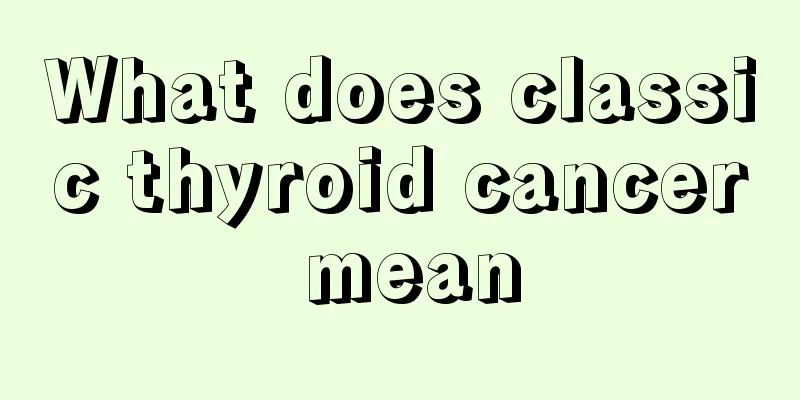What does classic thyroid cancer mean

|
The classic type of thyroid cancer usually refers to one of the most common types clinically. Thyroid cancer can be divided into four types according to different tissue origins: papillary carcinoma, follicular carcinoma, medullary carcinoma and undifferentiated carcinoma. Among them, papillary thyroid carcinoma is the most common, grows relatively slowly, and deteriorates less frequently. It is common in middle-aged women. It is recommended that patients seek medical attention in a timely manner and receive appropriate treatment measures under the doctor's clear diagnosis. The specific analysis is as follows: 1. Papillary thyroid cancer: It is a type of thyroid cancer with a relatively low degree of malignancy. It is usually related to radiation and genetic factors. Most patients have no obvious symptoms and are only accidentally discovered during physical examinations. As the thyroid gland continues to grow, symptoms such as local compression and dyspnea may occur. It can usually be treated through related surgeries such as lobectomy and isthmus resection or thyroidectomy. 2. Follicular thyroid cancer: Second only to papillary thyroid cancer, it is more common in women over 40 years old. In the early stage, it is easy to metastasize through the blood. Cancerous tissue may invade surrounding tissues and organs, resulting in symptoms such as hoarseness and dysphagia. It can usually be treated by lesion resection surgery, and radiotherapy is also needed for auxiliary treatment. 3. Medullary thyroid cancer: It is mainly caused by RET oncogene mutations, and mostly occurs in women between the ages of 30 and 60. After the onset of the disease, symptoms such as bilateral thyroid masses, shortness of breath, and hand and foot cramps generally appear. For cancer that has not metastasized, it can be treated by total thyroidectomy. For cancer that has metastasized, chemotherapy is also needed for adjuvant treatment. 4. Anaplastic thyroid cancer: It is usually the most malignant type of thyroid cancer, and is more common in elderly and weak patients. It develops quickly and usually presents with symptoms such as difficulty eating, coughing when drinking water, and pain in the thyroid area. The treatment is mainly surgical removal of the lesion, such as thyroid lobectomy or total thyroidectomy, and targeted therapy is also needed for auxiliary treatment. Thyroid cancer may not have obvious clinical symptoms in the early stage of the disease. As the disease progresses, symptoms such as local pain, dyspnea, dysphagia, and facial flushing may occur. It is recommended that patients go to the thyroid surgery or general surgery department of the hospital in time for surgical treatment. Radiotherapy and chemotherapy can also be used after surgery to inhibit the growth and spread of cancer cells. In daily life, pay attention to rest more, ensure adequate sleep time, avoid overwork, and go to the hospital for regular checkups. |
<<: Is breast calcification an early sign of breast cancer?
>>: Is glioma or lymphoma serious?
Recommend
How to prevent cervical cancer in daily life What are the common symptoms of cervical cancer
The prevention measures for cervical cancer are m...
Can patients with hepatitis B eat donkey hide gelatin cakes?
Hepatitis B virus (HBV) is a hepatitis B disease ...
What to do if you don't have confidence in yourself
Because of different growing environments and exp...
Are fruit preservatives toxic?
The fruits on the market now look particularly fr...
Feeling nauseous and wanting to vomit in the middle of the night
Nausea and vomiting in the middle of the night is...
Which sanitary napkin is the best
Sanitary napkins are used by every woman, so ever...
Why are there bugs in cherries
It is quite common to find bugs in cherries. This...
Long-term smoking can increase the incidence of laryngeal cancer
Smoking and laryngeal cancer are closely related....
How is white sugar made
White sugar is a food that is rich in sweetness a...
Which shoe sole is the most wear-resistant
We all know that shoes are an indispensable item ...
How can I wash off the oil stains on clothes?
A brand new and beautiful piece of clothing can m...
What are the effects of horse chestnut?
More and more economic crops are being developed ...
Is it normal for both noses to bleed at the same time
Many times, people experience nose bleeding, whic...
How to use orange peel to treat cough
Orange peel is very effective in relieving motion...
What is the function of toilet water?
Summer is here, and I believe many people will us...









